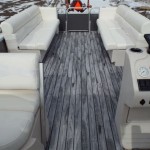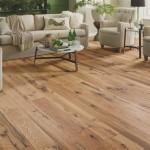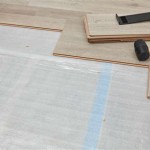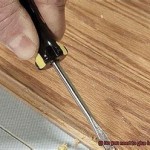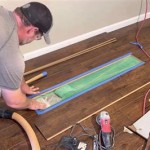Understanding the Hardness of Wood Flooring: A Comprehensive Chart and Guide
Wood flooring remains a popular choice for residential and commercial spaces due to its aesthetic appeal, durability, and potential for long-term value. However, not all wood flooring is created equal. The hardness of wood plays a significant role in its resistance to dents, scratches, and everyday wear and tear. Understanding the Janka hardness scale and how it applies to different wood species is crucial for selecting the right flooring for specific needs and environments.
This article provides a comprehensive overview of wood hardness, focusing on the Janka hardness test and its application in creating a helpful chart for informed decision-making. It will delve into the factors influencing wood hardness, discuss various wood species and their corresponding Janka ratings, and offer practical advice on selecting the appropriate wood flooring based on hardness considerations.
What is the Janka Hardness Scale?
The Janka hardness test is the industry standard for measuring the resistance of wood to indentation. Developed by Austrian-American botanist Gabriel Janka in the early 20th century, the test measures the force required to embed a .444-inch steel ball halfway into a piece of wood. The resulting force, measured in pounds-force (lbf), is the Janka rating. A higher Janka rating indicates a harder wood species.
It's important to note that the Janka rating is a comparative tool. It provides a standardized measure allowing consumers and professionals to compare the relative hardness of different wood species. It doesn't necessarily represent the absolute durability of the wood, as other factors like wood density, grain pattern, and finishing techniques also contribute to the overall performance of a wood floor.
The Janka hardness test is typically conducted on samples of wood that are at a specific moisture content, usually around 12%. This standardization ensures consistency and comparability across different species and testing facilities. Variations in moisture content can affect the hardness of wood, so controlling this factor is essential for accurate results.
The Janka hardness ratings are not the sole determinant of a good flooring choice, but they are a valuable piece of information to consider. Other factors, such as the wood's stability, resistance to moisture, color, grain pattern, and cost, should also be taken into account when selecting wood flooring.
Factors Influencing Wood Hardness
Several factors contribute to the hardness of a particular wood species. These include the wood's density, growth rate, cell structure, and moisture content. Understanding these factors helps in appreciating the variability in hardness among different wood types.
Density: Generally, denser woods are harder. Density refers to the mass of wood per unit volume. Wood species with tightly packed cells and thicker cell walls tend to be denser and, consequently, harder. This is because it takes more force to compress or indent the wood fibers.
Growth Rate: The growth rate of a tree also influences wood hardness. Slow-growing trees often produce denser and harder wood than fast-growing trees. This is because slower growth allows for the formation of tighter growth rings and denser wood tissue. The climate and environmental conditions in which a tree grows significantly impact its growth rate and, ultimately, its wood hardness.
Cell Structure: The arrangement and composition of wood cells also play a key role. Wood is composed of elongated cells arranged in specific patterns. The type and arrangement of these cells, as well as the composition of the cell walls (primarily cellulose and lignin), affect the wood's resistance to indentation. For example, woods with a higher proportion of lignin tend to be harder.
Moisture Content: As mentioned previously, moisture content significantly affects wood hardness. Wood is hygroscopic, meaning it absorbs and releases moisture from the surrounding environment. Wood that is overly dry can become brittle, while wood that is too moist can become softer. Maintaining a consistent moisture content is crucial for preserving the hardness and stability of wood flooring.
A Hardness Chart of Common Wood Flooring Species
The following chart provides a selection of common wood flooring species and their corresponding Janka hardness ratings. These ratings are approximate and may vary slightly depending on the specific source and growing conditions. This chart serves as a guide for comparing the relative hardness of different wood types.
Important note: These values are average Janka hardness ratings. Actual values may vary within a species depending on factors such as growing location and tree age.
Wood Species | Janka Hardness (lbf) ---|--- Brazilian Walnut (Ipe) | 3680 Brazilian Cherry (Jatoba) | 2350 Hickory | 1820 Hard Maple | 1450 Red Oak | 1290 White Oak | 1360 American Cherry | 950 Yellow Pine | 690 Douglas Fir | 660 Eastern White Pine | 420 Bamboo (Strand Woven) | Typically 3000+ (varies greatly) Cork | 300 - 400 (varies greatly)
Brazilian Walnut (Ipe): Boasting the highest Janka rating on this list, Ipe is exceptionally hard and durable, making it suitable for high-traffic areas and demanding environments. Its rich, dark color adds to its aesthetic appeal.
Brazilian Cherry (Jatoba): Another dense and durable option, Brazilian Cherry is known for its reddish-brown hue and resistance to dents and scratches. It is a popular choice for both residential and commercial applications.
Hickory: Hickory is a tough and resilient wood with a distinctive grain pattern. It is a good choice for active households and high-traffic areas where durability is paramount.
Hard Maple: Hard Maple is a close-grained wood with a light color. It is known for its strength and resistance to abrasion, making it a suitable option for dance floors and other demanding applications.
Red Oak: Red Oak is a widely used flooring option due to its availability, affordability, and moderate hardness. It has a distinctive reddish hue and a pronounced grain pattern.
White Oak: White Oak is slightly harder than Red Oak and is known for its water resistance. It has a more subdued grain pattern compared to Red Oak and is often preferred for its versatility.
American Cherry: American Cherry is a softer hardwood with a warm, reddish-brown color that deepens with age. It is a popular choice for creating a more traditional and elegant aesthetic but may be more susceptible to dents and scratches than harder species.
Yellow Pine: Yellow Pine is a softwood that is commonly used in flooring applications, particularly in older homes. It is relatively soft and prone to dents and scratches, but it offers a rustic and charming aesthetic.
Douglas Fir: Douglas Fir is another softwood that is often used in flooring, particularly in areas where a more rustic or vintage look is desired. It is softer than hardwoods and may require more care to prevent damage.
Eastern White Pine: Eastern White Pine is one of the softest wood flooring options. It is very prone to dents and scratches and primarily used where a rustic, distressed appearance is desired, or in areas with very light foot traffic. It is generally not recommended for high-traffic areas or homes with pets.
Bamboo (Strand Woven): Bamboo flooring hardness varies greatly depending on the manufacturing process. Strand woven bamboo is significantly harder than natural bamboo and can rival some hardwoods in terms of durability. It is an environmentally friendly option known for its strength and sustainability.
Cork: Cork flooring is a very soft option, providing excellent cushioning and sound absorption. However, its softness makes it susceptible to dents and scratches. It is best suited for areas with low foot traffic or where comfort is prioritized over durability. The Janka hardness of cork can also vary depending on the manufacturing process and density of the cork.
When selecting wood flooring, consider the level of activity in the space, the presence of children or pets, and personal aesthetic preferences. For high-traffic areas and homes with pets, harder wood species are generally recommended. For areas with less traffic or where a softer, more comfortable feel is desired, softer wood species may be appropriate.
The specific finish applied to wood flooring can also affect its resistance to wear and tear. A durable finish can help protect the wood from scratches, stains, and moisture damage. Consider the type of finish and its durability rating when selecting wood flooring.

Janka Hardness Scale Superior Flooring

Janka Hardness Scale Wood Maxx S

Janka Hardness Scale Impressions Flooring Collection

Janka Wood Flooring Hardness Chart

Janka Scale A Step Above Flooring Installation Inc

Hardwood Hardness Chart Floor Depot

Hardwood Floors Radiant Heat Real Goods Co

A Homeowner S Guide To Hardwood Floor Hardness Flooring

Wood Hardness Chart Schenck Company

What Is Janka Hardness And Why Does It Matter Anthology Woods
Related Posts


